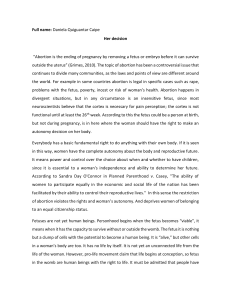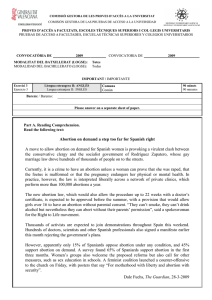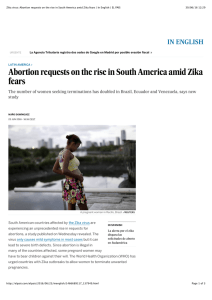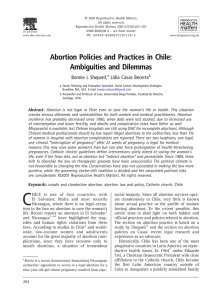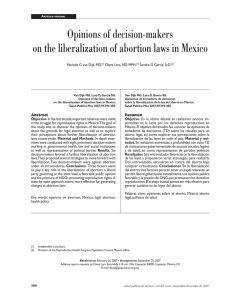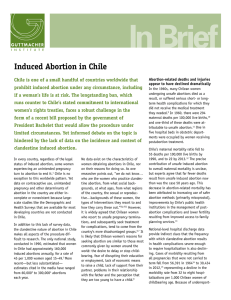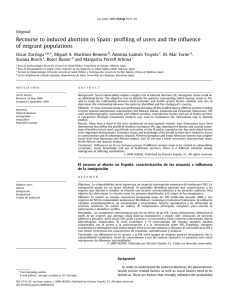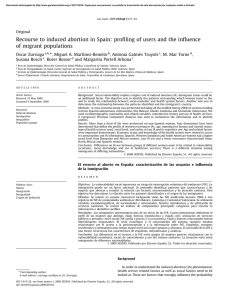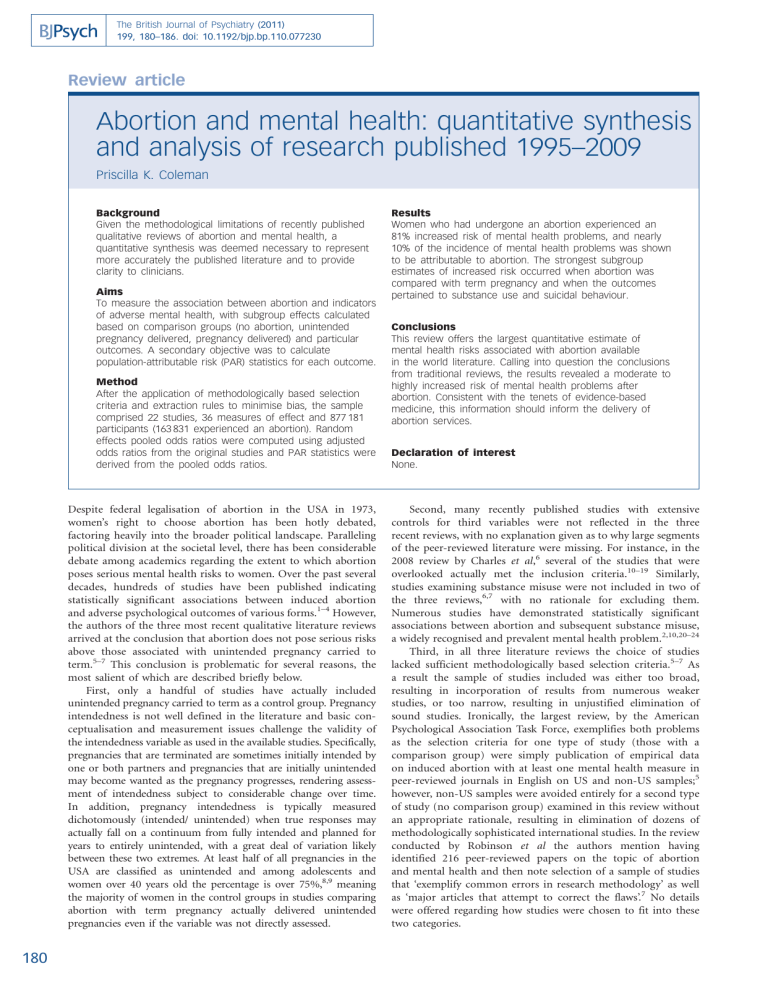
The British Journal of Psychiatry (2011) 199, 180–186. doi: 10.1192/bjp.bp.110.077230 Review article Abortion and mental health: quantitative synthesis and analysis of research published 1995–2009 Priscilla K. Coleman Background Given the methodological limitations of recently published qualitative reviews of abortion and mental health, a quantitative synthesis was deemed necessary to represent more accurately the published literature and to provide clarity to clinicians. Aims To measure the association between abortion and indicators of adverse mental health, with subgroup effects calculated based on comparison groups (no abortion, unintended pregnancy delivered, pregnancy delivered) and particular outcomes. A secondary objective was to calculate population-attributable risk (PAR) statistics for each outcome. Method After the application of methodologically based selection criteria and extraction rules to minimise bias, the sample comprised 22 studies, 36 measures of effect and 877 181 participants (163 831 experienced an abortion). Random effects pooled odds ratios were computed using adjusted odds ratios from the original studies and PAR statistics were derived from the pooled odds ratios. Despite federal legalisation of abortion in the USA in 1973, women’s right to choose abortion has been hotly debated, factoring heavily into the broader political landscape. Paralleling political division at the societal level, there has been considerable debate among academics regarding the extent to which abortion poses serious mental health risks to women. Over the past several decades, hundreds of studies have been published indicating statistically significant associations between induced abortion and adverse psychological outcomes of various forms.1–4 However, the authors of the three most recent qualitative literature reviews arrived at the conclusion that abortion does not pose serious risks above those associated with unintended pregnancy carried to term.5–7 This conclusion is problematic for several reasons, the most salient of which are described briefly below. First, only a handful of studies have actually included unintended pregnancy carried to term as a control group. Pregnancy intendedness is not well defined in the literature and basic conceptualisation and measurement issues challenge the validity of the intendedness variable as used in the available studies. Specifically, pregnancies that are terminated are sometimes initially intended by one or both partners and pregnancies that are initially unintended may become wanted as the pregnancy progresses, rendering assessment of intendedness subject to considerable change over time. In addition, pregnancy intendedness is typically measured dichotomously (intended/ unintended) when true responses may actually fall on a continuum from fully intended and planned for years to entirely unintended, with a great deal of variation likely between these two extremes. At least half of all pregnancies in the USA are classified as unintended and among adolescents and women over 40 years old the percentage is over 75%,8,9 meaning the majority of women in the control groups in studies comparing abortion with term pregnancy actually delivered unintended pregnancies even if the variable was not directly assessed. 180 Results Women who had undergone an abortion experienced an 81% increased risk of mental health problems, and nearly 10% of the incidence of mental health problems was shown to be attributable to abortion. The strongest subgroup estimates of increased risk occurred when abortion was compared with term pregnancy and when the outcomes pertained to substance use and suicidal behaviour. Conclusions This review offers the largest quantitative estimate of mental health risks associated with abortion available in the world literature. Calling into question the conclusions from traditional reviews, the results revealed a moderate to highly increased risk of mental health problems after abortion. Consistent with the tenets of evidence-based medicine, this information should inform the delivery of abortion services. Declaration of interest None. Second, many recently published studies with extensive controls for third variables were not reflected in the three recent reviews, with no explanation given as to why large segments of the peer-reviewed literature were missing. For instance, in the 2008 review by Charles et al,6 several of the studies that were overlooked actually met the inclusion criteria.10–19 Similarly, studies examining substance misuse were not included in two of the three reviews,6,7 with no rationale for excluding them. Numerous studies have demonstrated statistically significant associations between abortion and subsequent substance misuse, a widely recognised and prevalent mental health problem.2,10,20–24 Third, in all three literature reviews the choice of studies lacked sufficient methodologically based selection criteria.5–7 As a result the sample of studies included was either too broad, resulting in incorporation of results from numerous weaker studies, or too narrow, resulting in unjustified elimination of sound studies. Ironically, the largest review, by the American Psychological Association Task Force, exemplifies both problems as the selection criteria for one type of study (those with a comparison group) were simply publication of empirical data on induced abortion with at least one mental health measure in peer-reviewed journals in English on US and non-US samples;5 however, non-US samples were avoided entirely for a second type of study (no comparison group) examined in this review without an appropriate rationale, resulting in elimination of dozens of methodologically sophisticated international studies. In the review conducted by Robinson et al the authors mention having identified 216 peer-reviewed papers on the topic of abortion and mental health and then note selection of a sample of studies that ‘exemplify common errors in research methodology’ as well as ‘major articles that attempt to correct the flaws’.7 No details were offered regarding how studies were chosen to fit into these two categories. Abortion and mental health The fourth troubling issue is the fact that quantification of effects was not attempted by any of the three research teams. Given the expansive literature on abortion and mental health, there is no reasonable justification for not quantifying effects. In the only truly systematic review available, published in 2003 by Thorp et al, stringent selection criteria were employed and their analysis of the largest and strongest studies available resulted in the conclusion that abortion is associated with an increased risk of depression that may lead to self-harm.4 Owing to the broad objective of this review, which addressed physical complications as well, a wide range of mental health effects were not examined. In this highly politicised area of research it is imperative for researchers to apply scientifically based evaluation standards in a systematic, unbiased manner when synthesising and critiquing research findings. If not, authors open themselves up to accusations of shifting standards based on conclusions aligned with a particular political viewpoint. Moreover, the results may be dangerously misleading and result in misinformation guiding the practice of abortion. Through a process of systematically combining the quantitative results from numerous studies addressing the same basic question (e.g. ‘is there an association between abortion and mental health?’) far more reliable results are produced than from particular studies that are limited in size and scope. Moreover, as a methodology wherein studies are weighted based on objective scientific criteria, meta-analysis offers a logical, more objective alternative to qualitative reviews when the area of study is embedded in political controversy. Therefore, in an effort to provide a long overdue, dispassionate analysis of the literature on abortion and mental health, the primary objective of this review was to conduct meta-analyses of associations between induced abortion and adverse mental health outcomes (depression, anxiety, substance use and suicidal behaviour) with sensitivity to the use of distinct control groups employed in the various studies (no abortion, unintended pregnancy delivered, pregnancy delivered). The focus was on studies published between 1995 and 2009 because of the considerable improvement in research designs on the topic of post-abortion mental health in recent years. Contemporary research on abortion and mental health has addressed a number of shortcomings of the earlier work by employing comparison groups with controls for third variables. However, there has also been increased emphasis on incorporating nationally representative samples, prospective designs, controls for prior psychiatric history and comprehensive assessments of mental health outcome measures which in some cases included actual medical records. A secondary objective of this review was to calculate population-attributable risk (PAR) percentages using pooled odds ratios derived from the meta-analysis subdivided by outcome measures. These statistics reflect the incidence of a disorder in the exposed sample (e.g. women who have undergone abortion) that is directly due to the exposure (the abortion procedure). Both the pooled odds ratios and the PAR percentages yielded herein provide readily interpretable indices of the mental health consequences of abortion and should offer new clarity to the academic debate and to clinicians seeking information to guide effective practice. Method Inclusion criteria Studies identified using the Medline and PsycINFO databases were included in this review if they met the following criteria: a sample size of 100 or more participants; use of a comparison group (no abortion, pregnancy delivered or unintended pregnancy delivered); one or more mental health outcome variables (depression, anxiety, alcohol use, marijuana use or suicidal behaviour); controls for third variables; use of odds ratios to express effects observed to facilitate calculation of readily interpretable pooled odds ratios and PAR statistics; publication in English in peer-reviewed journals between 1995 and 2009. Rules for extraction and synthesis of effects In addition to the above criteria, rules for extracting and synthesising data derived from the studies selected were developed based on the recommendations outlined by Lipsey,25 to avoid overrepresentation of particular samples and statistical dependences among effects, and generally to ensure the most conservative and unbiased assemblage of results from the individual studies exhibiting considerable variability in reporting. (a) Relevant studies contributed a maximum of one effect per outcome. When authors reported more than one effect per variable based on separate analyses conducted for distinct demographic groups, or when different diagnoses were reported on within a general class such as anxiety or depression, a composite odds ratio was derived to avoid overweighting in favour of particular studies. (b) When studies had more than one comparison group, selection rules were employed to provide more weight to comparisons wherein the control group was most closely matched to the abortion group. Specifically, if ‘unintended pregnancy delivered’ was used the results relative to this group were selected, and when only ‘pregnancy delivered’ and ‘no abortion’ comparison groups were used, the effects pertaining to the ‘pregnancy delivered’ group were selected. (c) In situations wherein separate results were reported based on one v. two or more abortions, the results specific to one abortion were selected to enable sampling of a more homogeneous population. There are studies suggesting differential effects based on the number of abortions.26,27 (d) When particular authors used the same sample and variables in more than one publication, only the most recent publication was selected. When the same data-set was used by different groups, both sets of results were included when distinct samples were defined. Statistical analysis Meta-analyses were conducted using Comprehensive Meta-Analysis version 2.0 for Windows (Biostat, www.meta-analysis.com). Random effects meta-analyses were computed based on the sociodemographic heterogeneity of the study samples.43 The random effects model takes into account two sources of variance (within-study error and variation in the true effects across studies) with the study weights designed to minimise both sources of variance.43 A pooled odds ratio was computed using the full 36 effects extracted. In addition, two sets of subgroup pooled odds ratios were calculated based on the type of comparison group used and on specific forms of mental health problems. Adjusted odds ratios with controls for third variables were used in all the random effects meta-analyses. Finally, PAR percentages were computed using the pooled odds ratios (OR) derived from the random effects model subdivided by outcome measures. The PAR percentages were calculated using the formula 1006(Px(OR71))/ (1 + Px(OR71)), where Px is the estimate of population exposure; Px is calculated as c / (c + d), where c is the number of women in the abortion group who did not experience the mental illness in question and d is the number of women in the ‘no abortion’ group who were identified as not having the mental illness examined. 181 Coleman Results After applying the inclusion criteria and rules detailed above, the sample consisted of 22 peer-reviewed studies (15 from the USA and 7 from other countries);3,20–22,24,26–42 these comprised 36 measures of effect (9 alcohol use/misuse, 5 marijuana, 7 anxiety, 11 depression, 4 suicidal behaviour) and a total of 877 181 participants, of whom 163 831 had experienced an abortion (see online Table DS1). The first random effects meta-analysis, which included 36 adjusted odds ratios from the 22 studies identified, resulted in a pooled odds ratio of 1.81 (95% CI 1.57–2.09, P50.0001). The results of this analysis indicated that women who have had an abortion experienced an 81% higher risk of mental health problems of various forms when compared with women who had not had an abortion (Fig. 1). Results of a second random effects meta-analysis, wherein separate effects were produced based on the type of outcome measure, are provided in Fig. 2. All effects were statistically significant, with the largest pooled odds ratio derived for marijuana use (OR = 3.30, 95% CI 1.64– 7.44, P = 0.001), followed by suicide behaviours (OR = 2.55, 95% CI 1.31–4.96, P = 0.006), alcohol use/misuse (OR = 2.10, 95% CI 1.77–2.49, P50.0001), depression (OR = 1.37, 95% CI 1.22– 1.53, P50.0001) and anxiety (OR = 1.34, 95% CI 1.12–1.59, P50.0001). These results indicate that the level of increased risk associated with abortion varies from 34% to 230% depending on the nature of the outcome. In the third random effects meta-analysis (Fig. 3) three separate pooled odds ratios were produced based on the type of comparison group employed in the respective studies. When women who had terminated a pregnancy were compared with women who had not done so relative to all mental health problems, the result was statistically significant (OR = 1.59, 95% CI 1.36–1.85, P50.0001). When women who terminated a pregnancy were compared with women who carried to term, using the full set of mental health variables, the result was considerably stronger (OR = 2.38, 95% CI 1.62–3.50, P50.0001). Finally, when ‘unintended pregnancy carried to term’ operated as the comparison group, the result was likewise statistically significant and closer to the result relative to the ‘no abortion’ comparison group (OR = 1.55, 95% CI 1.30–1.83, P50.0001). These data indicate that regardless of the type of comparison group used, abortion is associated with an enhanced risk of experiencing mental health problems, with the magnitude of this risk ranging from 55% to 138%. The last set of analyses involved calculation of PAR percentages based on pooled odds ratio estimates. The overall PAR percentage was nearly 10%, with the range for particular mental health problems extending from 8.3% for anxiety to 26.5% for marijuana use (Table 1). In addition, a pooled odds ratio for the two large-scale studies in which actual suicide was Statistics for each study Study name Upper Odds limit ratio 10 Coleman 2006 alco 27.268 5.720 Coleman 200610 marij 40.697 9.000 20 Coleman et al 2009 alco 2.595 1.898 20 Coleman et al 2009 anx 2.348 1.787 20 Coleman et al 2009 dep 1.776 1.405 28 Coleman et al 2009 alco 6.810 3.390 26 Coleman et al 2005 alco 2.761 1.620 29 Coleman et al 2002 alco 3.474 2.396 29 Coleman et al 2002 marij 13.787 8.554 Coleman et al 200230 anx 1.300 1.140 Coleman et al 200230 dep 1.375 1.160 Cougle et al 200532 anx 1.705 1.340 Cougle et al 200332 dep 2.420 1.639 21 Dingle et al 2008 dep 2.449 1.500 21 Dingle et al 2008 alco 3.446 2.100 21 Dingle et al 2008 anx 2.449 1.500 21 Dingle et al 2008 marij 2.500 1.500 22 Fergusson et al 2008 suic ideation 3.171 1.610 22 Fergusson et al 2008 alco 8.196 2.880 Fergusson et al 200822 anx 3.649 2.130 Fergusson et al 200822 dep 2.224 1.310 Gilchrist et al 199533 self-harm 2.614 1.700 Gissler et al 199634 suic 9.784 5.900 Pederson 200724 alco 3.717 2.000 24 Pederson 2007 marij 6.411 3.400 35 Pederson 2008 dep 5.484 1.750 35 Reardon & Cougle 2002 dep 2.608 1.540 39 Reardon et al 2004 alco 3.112 1.720 39 Reardon et al 2004 marij 3.390 2.000 38 Reardon et al 2003 dep 2.623 1.924 Reardon et al 200237 suic 5.665 2.540 Rees & Sabia 200740 dep 4.573 2.150 Schmiege & Russo 200541 dep 1.663 1.190 Steinberg & Russo 200827 anx/NCS 1.420 0.914 Steinberg & Russo 200827 anx/NCFG 1.609 1.210 42 Taft & Watson 2008 dep 1.507 1.220 Total 2.092 1.814 Lower limit Z 1.200 2.189 1.990 2.854 1.388 4.014 1.360 4.171 1.111 2.841 1.688 3.430 0.950 1.773 1.652 4.609 5.307 8.814 1.000 1.958 0.979 1.711 1.053 2.381 1.110 2.485 0.919 1.620 1.280 2.937 0.919 1.620 0.900 1.556 0.818 1.377 1.012 1.982 1.243 2.752 0.772 1.000 1.106 2.418 3.558 6.878 1.076 2.192 1.803 3.782 0.558 0.960 0.909 1.606 0.951 1.793 1.180 2.575 1.411 4.140 1.139 2.278 1.011 1.988 0.852 1.019 0.588 70.400 0.910 1.310 0.988 1.846 1.573 8.195 Odds ratio and 95% Ci P 0.029 0.004 0.000 0.000 0.004 0.001 0.076 0.000 0.000 0.050 0.087 0.017 0.013 0.105 0.003 0.105 0.120 0.168 0.047 0.006 0.317 0.016 0.000 0.028 0.000 0.337 0.108 0.073 0.010 0.000 0.023 0.047 0.308 0.689 0.190 0.065 0.000 0 0 0 0 0 0 0 0 0 0 0 0 0 0 0 0 0 0 0 0 0 0 0 0 0 0 0 0 0 0 0 0 0 0 0 0 < 0.01 0.1 Favours no abortion 1 10 Favours abortion Fig. 1 Abortion and subsequent mental health outcomes. alco, alcohol misuse; anx, anxiety; dep, depression; marij, marijuana use; NCS, National Comorbidity Survey; NCFG, National Survey of Family Growth; suic, suicide. 182 100 Abortion and mental health Statistics for each study Study name Alcohol Coleman 200610 Coleman et al 200920 Coleman et al 200928 Coleman et al 200526 Coleman et al 200229 Dingle et al 200821 Fergusson et al 200822 Pederson 200724 Reardon et al 200439 All alcohol Anxiety Coleman et al 200920 Coleman et al 200230 Cougle et al 200532 Dingle et al 200821 Fergusson et al 200822 Steinberg & Russo 200827 NCS Steinberg & Russo 200827 NCFG All anxiety Depression Coleman et al 200920 Coleman et al 200229 Cougle et al 200331 Dingle et al 200821 Fergusson et al 200822 Pedersen 200835 Reardon & Cougle 200236 Reardon et al 200338 Rees & Sabia 200740 Schmiege & Russo 200541 Taft & Watson 200842 All depression Marijuana use Coleman 200610 Coleman et al 200229 Dingle et al 200821 Pedersen 200724 Reardon et al 200439 All marijuana use Suicide and self-harm Fergusson et al 200822 suic ideation Gilchrist et al 199533 self-harm Gissler et al 199634 suic Reardon et al 200237 suic All suicide/self-harm Upper Odds limit ratio Lower limit Z P 27.268 2.595 6.810 2.761 3.474 3.446 8.196 3.717 3.112 2.494 5.720 1.898 3.390 1.620 2.396 2.100 2.880 2.000 1.720 2.100 1.200 1.388 1.688 0.950 1.652 1.280 1.012 1.076 0.951 1.768 2.189 4.014 3.430 1.773 4.609 2.937 1.982 2.192 1.793 8.464 0.029 0.000 0.001 0.076 0.000 0.003 0.047 0.028 0.073 0.000 2.348 1.300 1.705 2.449 3.649 1.420 1.609 1.599 1.787 1.140 1.340 1.500 2.130 0.914 1.210 1.340 1.380 4.171 1.000 1.958 1.053 2.381 0.919 1.620 1.243 2.752 0.588 70.400 0.910 1.310 1.123 3.253 0.000 0.050 0.017 0.105 0.006 0.689 0.190 0.001 1.776 1.375 2.420 2.449 2.224 5.484 2.608 2.623 4.573 1.663 1.507 1.535 1.405 1.160 1.639 1.500 1.310 1.750 1.540 1.924 2.150 1.190 1.220 1.370 1.111 0.979 1.110 0.919 0.772 0.558 0.909 1.411 1.011 0.852 0.988 1.223 2.841 1.711 2.485 1.620 1.000 0.960 1.606 4.140 1.988 1.019 1.846 5.421 0.004 0.087 0.013 0.105 0.317 0.337 0.108 0.000 0.047 0.308 0.065 0.000 40.697 13.787 2.500 6.411 3.390 7.441 9.000 8.554 1.500 3.400 2.000 3.503 1.990 5.307 0.900 1.803 1.180 1.649 2.854 8.814 1.556 3.782 2.575 3.261 0.004 0.000 0.120 0.000 0.010 0.001 3.171 2.614 9.784 5.665 4.964 1.610 1.700 5.900 2.540 2.552 0.818 1.106 3.558 1.139 1.312 1.377 2.418 6.878 2.278 2.759 0.168 0.016 0.000 0.023 0.006 Odds ratio and 95% CI 0 0 0 0 0 0 0 0 0 0 0 0 0 0 0 0 0 0 0 0 0 0 0 0 0 0 0 < 0 0 0 0 0 0 0 0 0 0.01 0.1 Favours no abortion 1 10 100 Favours abortion Fig. 2 Abortion and subsequent mental health outcomes, organised by dependent measures. NCS, National Comborbidity Survey; NCFG, National Survey of Family Growth; suic, suicide. measured yielded a significant result (OR = 4.11, 95% CI 1.82– 9.31) and a PAR percentage of 34.9% was derived using this pooled odds ratio. Discussion Based on data extracted from 22 studies, the results of this meta-analytic review of the abortion and mental health literature indicate quite consistently that abortion is associated with moderate to highly increased risks of psychological problems subsequent to the procedure. The magnitude of effects derived varied based on the comparison group (no abortion, pregnancy delivered, unintended pregnancy delivered) and the type of problem examined (alcohol use/misuse, marijuana use, anxiety, depression, suicidal behaviours). Overall, the results revealed that women who had undergone an abortion experienced an 81% increased risk of mental health problems, and nearly 10% of the incidence of mental health problems was shown to be directly attributable to abortion. The strongest effects were observed when women who had had an abortion were compared with women who had carried to term and when the outcomes measured related Table 1 Population-attributable risk (PAR) percentages based on outcome measure Outcome PAR % Anxiety Depression Alcohol use Marijuana use All suicidal behaviours Suicide All 8.1 8.5 10.7 26.5 20.9 34.9 9.9 to substance use and suicidal behaviour. Great care was taken to assess accurately the risks from the most methodologically sophisticated studies, and the quantitatively based conclusions reflect data gathered on over three-quarters of a million women. Of particular significance is the fact that all effects entered into the analyses were adjusted odds ratios with controls for numerous third variables. The finding that abortion is associated with significantly higher risks of mental health problems compared with carrying 183 Coleman Statistics for each study Study name Delivery Coleman et al 200828 alco Coleman et al 200229 alco Coleman et al 200229 marij Coleman et al 200230 anx Coleman et al 200230 dep Cougle et al 200331 dep Gissler et al 199634 suic Pederson 200835 dep Reardon et al 200338 dep Reardon et al 200237 suic All delivery No abortion Coleman et al 200920 alco Coleman et al 200920 anx Coleman et al 200920 dep Coleman et al 200526 alco Dingle et al 200821 dep Dingle et al 200821 alco Dingle et al 200821 anx Dingle et al 200821 marij Pedersen 200724 alc Pedersen 200724 marij Rees & Sabia 200740 dep Steinberg & Russo 200827 anx/NCS Taft & Watson 200842 dep All no abortion Unintended pregnancy Coleman 200610 alco Coleman 200610 marij Cougle et al 200532 anx Fergusson et al 200822 suic ideation Fergusson et al 200822 alco Fergusson et al 200822 anx Fergusson et al 200822 dep Gilchrist et al 199533 self-harm Reardon & Cougle 200236 dep Reardon et al 200439 alco Reardon et al 200439 marij Schmiege & Russo 200541 dep Steinberg & Russo 200827 anx/NCFG All unintended pregnancy Upper limit 6.810 3.474 13.787 1.300 1.375 2.420 9.784 5.484 2.623 5.665 3.502 Odds ratio 3.390 2.396 8.554 1.140 1.160 1.639 5.900 1.750 1.924 2.540 2.386 Lower limit 1.688 1.652 5.307 1.000 0.979 1.110 3.558 0.568 1.411 1.139 1.626 Z 3.430 4.609 8.814 1.958 1.711 2.485 6.878 0.960 4.140 2.278 4.443 P 0.001 0.000 0.000 0.050 0.087 0.013 0.000 0.337 0.000 0.023 0.000 2.595 2.348 1.776 2.761 2.449 3.446 2.449 2.500 3.717 6.411 4.573 1.420 1.507 1.856 1.898 1.787 1.405 1.620 1.500 2.100 1.500 1.500 2.000 3.400 2.150 0.914 1.220 1.592 1.388 4.014 1.380 4.171 1.111 2.841 0.950 1.773 0.919 1.620 1.280 2.937 0.919 1.620 0.900 1.556 1.076 2.192 1.803 3.782 1.011 1.988 0.58870.400 0.988 1.846 1.366 5.939 0.000 0.000 0.004 0.076 0.105 0.002 0.105 0.120 0.028 0.000 0.047 0.689 0.065 0.000 27.268 40.697 1.705 3.171 8.196 3.649 2.224 2.614 2.608 3.112 3.390 1.663 1.609 1.836 5.720 9.000 1.340 1.610 2.880 2.130 1.310 1.700 1.540 1.720 2.000 1.190 1.210 1.551 1.200 1.990 1.053 0.818 1.012 1.243 0.772 1.106 0.909 0.951 1.180 0.852 0.910 1.309 0.029 0.004 0.017 0.168 0.047 0.006 0.317 0.016 0.108 0.073 0.010 0.308 0.190 0.000 2.189 2.854 2.381 1.377 1.982 2.752 1.000 2.418 1.606 1.793 2.575 1.019 1.310 5.082 Odds ratio and 95% CI 0 0 0 0 0 0 0 0 0 0 0 0 0 0 0 0 0 0 0 0 0 0 0 0 < 0 0 0 0 0 0 0 0 0 0 0 0 0 0.01 0.1 Favours no abortion 1 10 100 Favours abortion Fig. 3 Abortion and subsequent mental health outcomes, organised by comparison group. alco, alcohol misuse; anx, anxiety; dep, depression; marij, marijuana use; NCS, National Comorbidity Survey; NCFG, National Survey of Family Growth; suic, suicide. a pregnancy to term is consistent with literature demonstrating protective effects of pregnancy delivered relative to particular mental health outcomes. For example, with regard to suicide, Gissler et al reported the annual suicide rate for women of reproductive age to be 11.3 per 100 000, whereas the rate was only 5.9 per 100 000 in association with birth.34 Several other studies conducted in different countries have revealed even lower rates of suicide following birth when compared with women in the general population.44–47 More research is needed to examine systematically the specific nature of this protective effect against suicide, to determine the extent to which the protective effect holds for unintended pregnancies delivered, and to examine possible protective effects of childbirth relative to other mental health variables. When the abortion group was compared with the no pregnancy group and with the unintended pregnancy delivered group, the magnitude of the effects was very close. This finding challenges the generally accepted belief that unintended pregnancy delivered represents the only or most appropriate control group for studies designed to explore the impact of abortion on mental health. Use of a no pregnancy delivered group may be a cleaner control group, since many women experience postpartum depression and/or anxiety following childbirth. From a practical standpoint, a no pregnancy comparison group should be 184 considerably easier to secure than a group of women who deliver an unintended pregnancy. Future research Future studies should explore possible process mechanisms linking abortion to substance misuse and suicidal behaviour, since the strongest effects were detected for these variables. For example, substance misuse and suicidal behaviour may result from efforts to block or avoid any psychological pain associated with the procedure and may be construed as faster, easier remedies for personal suffering than seeking professional help. Women could find it particularly difficult to reach out to others if they experience shame or guilt associated with the abortion. Consistent with the contemporary ethos of evidence-based medicine wherein effective use is made of the best available data from systematic research, firm standards should be articulated for accessing and synthesising information from the published literature for the purpose of training healthcare personnel. The results of this systematic, quantitative review cast serious doubt on the conclusions derived from the recently published traditional reviews described earlier,5–7 and suggest that there are in fact some real risks associated with abortion that should be shared with women as they are counselled prior to an abortion decision. Abortion and mental health Healthcare professionals are responsible for educating patients in a manner that reflects the current scientific literature; however, the average practitioner does not generally have the time and expertise to study and attempt to resolve conflicting interpretations of the published research in order to extract the most reliable information. The responsibility therefore rests initially within the research community to set aside personal ideological commitments, objectively examine all high-quality published data, and conduct analyses of the literature that are based on state-ofthe-art data analysis procedures, yielding readily interpretable synopses as has been attempted here. Once this goal is satisfactorily realised, professional organisations will face the challenge of developing efficient protocols for informing practitioners and for streamlining the dissemination of information to the public. The US Preventive Services Task Force (USPSTF) within the Agency for Healthcare Research and Quality, which is a division of the US Department of Health and Human Services (www. ahrq.gov/clinic/3rduspstf/ratings.htm), has identified basic guidelines for how scientific evidence should be used to inform practice. These are summarised below and are based on an analysis of risks and benefits as established in the scientific literature. . Level A: Good scientific evidence indicates the benefits of the service substantially outweigh the risks with clinicians advised to discuss the service with eligible patients. . Level B: Fair scientific evidence indicates the benefits of the service outweigh the risks with clinicians encouraged to discuss the service with eligible patients. . Level C: At least fair scientific evidence indicating benefits are provided by the service, but the balance between benefits and risks precludes general recommendations. Clinicians are advised to only offer the service if there are special considerations. . Level D: At least fair scientific evidence indicates the risks of the service outweigh benefits with clinicians advised not to routinely offer the service. . Level I: Scientific evidence is deficient, poorly done, or conflicting precluding assessment of the risk benefit ratio. Clinicians are advised to convey the uncertainty of evidence surrounding the service to patients. Putative benefits of abortion Procedure benefits of abortion have not been empirically established and the results of the substantial review by Thorp et al described earlier in conjunction with the results of the present quantitative synthesis indicate considerable evidence documenting mental health risks.4 Without more research pertaining to possible benefits, the above guidelines are difficult to apply. In one study by Major et al,14 the average response of the study respondents reflecting their positive post-abortion emotional reactions (defined as ‘happy’, ‘pleased’ or ‘satisfied’) was 2.24 on a scale of 1 to 5, with 1 corresponding to ‘not at all’ and a 5 representing ‘a great deal’. The passage of time apparently did not result in more positive emotions, because 2 years after abortion the average rating dropped by a statistically significantly amount to 2.06. A few additional studies have addressed associations between abortion and educational attainment, income and other outcomes of this nature, which may be construed as indirect indicators of mental health;48,49 however, mental health benefits have received scant direct attention in the literature. Concerns regarding the deficient positive effects literature were echoed in an editorial published in the Psychiatric Bulletin,50 in which Fergusson questioned the legitimacy of justifying over 90% of UK abortions based on the presumption that abortion offers the benefit of reducing mental health risks associated with continuing the pregnancy. Fergusson specifically stated: Although decisions on whether to proceed with induced abortion are made on the basis of clinical assessments of the extent to which abortion poses a risk to maternal mental health, these clinical assessments are not currently supported by populationlevel evidence showing the provision of abortion reduces mental health risks for women having unwanted pregnancy.50 Until sound evidence documenting mental health benefits of abortion is available, clinicians should convey the current state of uncertainty related to benefits of abortion in addition to sharing the most accurate information pertaining to statistically validated risks. Strengths and limitations of this review Motivated by the shortcomings of previous non-quantitative efforts to synthesise and analyse a complex literature prone to biased interpretations, I have attempted in this study to evaluate systematically a wealth of data on the topic of abortion and mental health. The use of inclusion criteria that resulted in incorporation of the largest and strongest studies published in recent years is an obvious strength. However, the review is clearly not exhaustive as only a 15-year publication window was examined and studies that did not incorporate a comparison group were not analysed. There is a strong need for a quantitative review of literature examining the hundreds of studies that have been conducted on samples of women who obtained abortions without inclusion of a comparison group. As noted previously, the review of literature conducted by the American Psychological Association Task Force confined their examination of this study form to US samples.5 Another limitation of my study relates to the lack of uniformity in control variables, demographic characteristics of the samples, length of time between the procedure and the follow-up assessments, and considerable variation in how the outcomes were measured. It is encouraging to note that methodologically sophisticated studies on the topic of abortion and mental health are being published at a significantly higher rate than ever before. Researchers throughout the world are seeking to understand the experience of induced abortion more fully and are increasingly willing to take on a subject that has been shrouded in political controversy and has not received the scholarly attention it deserves. The latest example is a study based on National Comorbidity Survey – Replication data by Canadian researchers Mota et al.51 This 2010 study was published after the analyses reported herein were conducted; however, its results are startlingly similar. Statistically significant associations were observed between abortion history and a wide range of mental health problems after controlling for the experience of interpersonal violence and demographic variables. When compared with women without an abortion history, women with a prior abortion experienced a 61% increased risk of mood disorders. Abortion was further linked with a 61% increased risk of social phobia, and increased the risk of suicide ideation by 59%. In the realm of substance misuse, the abortion-related increased risks for alcohol misuse, alcohol dependence, drug misuse, drug dependence and any substance use disorder were 261%, 142%, 313%, 287% and 280% respectively. Population-attributable risk percentages were likewise similar, ranging from 5.8% to 24.7%.51 Concluding remarks This review was undertaken in an effort to produce an unbiased, quantitative analysis of the best available evidence addressing abortion as one risk factor among many others that may increase the likelihood of mental health problems. The composite results reported herein indicate that abortion is a statistically validated risk factor for the development of various psychological disorders. However, when the independent variable cannot be ethically manipulated, as is the case with abortion history, definitive causal 185 Coleman conclusions are precluded from both individual studies and from a quantitative synthesis such as this one. Although an answer to the causal question is not readily discerned based on the data available, as more prospective studies with numerous controls are being published, indirect evidence for a causal connection is beginning to emerge. Priscilla K. Coleman, Human Development and Family Studies, 16 D FCS Building, Bowling Green State University, Bowling Green, Ohio 43402, USA. Email: pcolema@bgnet.bgsu.edu First received 1 Jan 2010, final revision 5 Oct 2010, accepted 21 Mar 2011 References 23 Fergusson DM, Horwood LJ, Ridder EM. Abortion in young women and subsequent mental health. J Child Psychol Psychiatry 2006; 47: 16–24. 24 Pedersen W. Childbirth, abortion and subsequent substance use in young women: a population-based longitudinal study. Addiction 2007; 102: 1971–8. 25 Lipsey MW. Identifying interesting variables and analysis opportunities. In The Handbook of Research Synthesis and Meta-Analysis, 2nd edn (eds H Cooper, LV Hedges, JC Valentine): 147–58. Russell Sage Foundation, 2009. 26 Coleman PK, Reardon DC, Cougle J. Substance use among pregnant women in the context of previous reproductive loss and desire for current pregnancy. Br J Health Psychol 2005; 10: 255–68. 27 Steinberg JR, Russo NF. Abortion and anxiety: what’s the relationship? Soc Sci Med 2008; 67: 238–52. 1 Bradshaw Z, Slade P. The effects of induced abortion on emotional experiences and relationships: a critical review of the literature. Clin Psychol Rev 2003; 23: 929–58. 28 Coleman PK, Maxey DC, Spence M, Nixon C. The choice to abort among mothers living under ecologically deprived conditions: predictors and consequences. Int J Ment Health Addiction 2009; 7: 405–22. 2 Coleman PK. Induced abortion and increased risk of substance use: a review of the evidence. Curr Women’s Health Rev 2005; 1: 21–34. 29 Coleman PK, Reardon DC, Rue V, Cougle J. History of induced abortion in relation to substance use during subsequent pregnancies carried to term. Am J Obstet Gynecol 2002; 187: 1673–8. 3 Coleman PK, Reardon DC, Strahan TS, Cougle JR. The psychology of abortion: a review and suggestions for future research. Psychol Health 2005; 20: 237–71. 4 Thorp J, Hartman K, Shadigan E. Long-term physical and psychological health consequences of induced abortion: review of the evidence. Obstet Gynecol Surv 2003; 58: 67–79. 5 American Psychological Association Task Force on Mental Health and Abortion. Report of the American Psychological Association Task Force on Mental Health and Abortion. APA, 2008. 6 Charles VE, Polis CB, Sridhara SK, Blum RW. Abortion and long-term mental health outcomes: a systematic review of the evidence. Contraception 2008; 78: 436–50. 7 Robinson GE, Stotland NL, Russo NF, Lang JA, Occhiogrosso M. Is there an ‘abortion trauma syndrome’? Critiquing the evidence. Harv Rev Psychiatry 2009; 17: 268–90. 8 Kost K, Forrest JD. Intention status of US births in 1988: differences by mothers’ socioeconomic and demographic characteristics. Fam Plann Perspect 1995; 27: 11–7. 9 Squires S. Most pregnancies unplanned or unwanted, study says. Washington Post 9 May 1995; 11: 7. 10 Coleman PK. Resolution of unwanted pregnancy during adolescence through abortion versus childbirth: individual and family predictors and consequences. J Youth Adolesc 2006; 35: 903–11. 11 Henshaw R, Naji S, Russell I, Templeton A. Psychological responses following medical abortion (using mifepristone and gemeprost) and surgical vacuum aspiration: a patient-centered, partially randomized prospective study. Acta Obstet Gynec Scand 1994; 73: 812–8. 12 Lauzon P, Roger-Achim D, Achim A, Boyer R. Emotional distress among couples involved in first trimester abortions. Can Fam Physician 2000; 46: 2033–40. 13 Lyndon J, Dunkel-Schetter C, Cohan CL, Pierce T. Pregnancy decision making as a significant life event: a commitment approach. J Pers Soc Psychol 1996; 71: 141–51. 14 Major B, Cozzarelli C, Cooper ML, Zubek J, Richards C, Wilhite M, et al. Psychological responses of women after first trimester abortion. Arch Gen Psychiatry 2000; 57: 777–84. 30 Coleman PK, Reardon DC, Rue V, Cougle J. State-funded abortions vs. deliveries: a comparison of outpatient mental health claims over four years. Am J Orthopsychiatry 2002; 72: 141–52. 31 Cougle J, Reardon DC, Coleman PK. Depression associated with abortion and childbirth: a long-term analysis of the NLSY cohort. Med Sci Monit 2003; 9: CR105–12. 32 Cougle J, Reardon DC, Coleman PK, Rue VM. Generalized anxiety associated with unintended pregnancy: a cohort study of the 1995 National Survey of Family Growth. J Anxiety Disord 2005; 19: 137–42. 33 Gilchrist AC, Hannaford PC, Frank P, Kay CR. Termination of pregnancy and psychiatric morbidity. Br J Psychiatry 1995; 167: 243–8. 34 Gissler M, Hemminki E, Lonnqvist J. Suicides after pregnancy in Finland, 1987–94: register linkage study. BMJ 1996; 313: 1431–4. 35 Pedersen W. Abortion and depression: a population-based longitudinal study of young women. Scand J Public Health 2008; 36: 424–8. 36 Reardon DC, Cougle J. Depression and unintended pregnancy in the National Longitudinal Survey of Youth: a cohort study. BMJ 2002; 324: 151–2. 37 Reardon DC, Cougle J, Ney PG, Scheuren F, Coleman PK, Strahan TW. Deaths associated with delivery and abortion among California Medicaid patients: a record linkage study. South Med J 2002; 95: 834–41. 38 Reardon DC, Cougle J, Rue VM, Shuping M, Coleman PK, Ney PG. Psychiatric admissions of low-income women following abortion and childbirth. CMAJ 2003; 168: 1253–6. 39 Reardon DC, Coleman PK, Cougle J. Substance use associated with prior history of abortion and unintended birth: a national cross sectional cohort study. Am J Drug Alcohol Abuse 2004; 26: 369–83. 40 Rees DI, Sabia JJ. The relationship between abortion and depression: new evidence from the Fragile Families and Child Wellbeing Study. Med Sci Monit 2007; 13: 430–6. 41 Schmiege S, Russo NF. Depression and unwanted first pregnancy: longitudinal cohort study. BMJ 2005; 331: 1303. 42 Taft AJ, Watson LF. Depression and termination of pregnancy (induced abortion) in a national cohort of young Australian women: the confounding effect of women’s experience of violence. BMC Public Health 2008; 8: 75. 15 Major B, Cozzarelli C, Sciacchitano AM, Cooper ML, Testa M, Mueller PM. Perceived social support, self-efficacy, and adjustment to abortion. J Pers Soc Psychol 1990; 59: 186–97. 43 Borenstein M, Hedges LV, Higgins JPT, Rothstein HR. Introduction to MetaAnalysis. Wiley, 2009. 16 Miller WB. An empirical study of the psychological antecedents and consequences of induced abortion. J Soc Issues 1992; 48: 67–93. 44 Appleby L. Suicide during pregnancy and in the first postnatal year. BMJ 1991; 302: 137–40. 17 Miller WB, Pasta DJ, Dean CL. Testing a model of the psychological consequences of abortion. In The New Civil War: The Psychology, Culture, and Politics of Abortion (eds LJ Beckman, SM Harvey): pp. 235–67. American Psychological Association, 1998. 18 Reardon DC, Coleman PK. Relative treatment rates for sleep disorders following abortion and childbirth: a prospective record-based study. Sleep 2006; 29: 105–6. 19 Slade P, Heke S, Fletcher J, Stewart PA. comparison of medical and surgical methods of termination of pregnancy: choice, psychological consequences, and satisfaction with care. Br J Obstet Gynaecol 1998; 105: 1288–95. 20 Coleman PK, Coyle CT, Shuping M, Rue VM. Induced abortion and anxiety, mood, and substance abuse disorders: isolating the effects of abortion in the National Comorbidity Survey. J Psychiatr Res 2009; 43: 770–6. 21 Dingle K, Alati R, Clavarino A, Najman JM, Williams GM. Pregnancy loss and psychiatric disorders in young women: an Australian birth cohort study. Br J Psychiatry 2008; 193: 455–60. 186 22 Fergusson DM, Horwood LJ, Boden JM. Abortion and mental health disorders: evidence from a 30-year longitudinal study. Br J Psychiatry 2008; 193: 444–51. 45 Kleiner GJ, Greston WM (eds). Suicide in Pregnancy. John Wright, 1984. 46 Lindahl V, Pearson JL, Colpe L. Prevalence of suicidality during pregnancy and the postpartum. Arch Womens Ment Health 2005; 8: 77–87. 47 Schiff MA, Grossman DC. Adverse perinatal outcomes and risk of postpartum suicide attempt in Washington State, 1987–2001. Pediatrics 2006; 118: e669–75. 48 Bailey PE, Bruno ZV, Bezerra MF, Queiroz J, Oliveira CM, Chen-Mok M. Adolescent pregnancy 1 year later: the effects of abortion vs. motherhood in Northeast Brazil. J Adolesc Health 2001; 29: 223–32. 49 Fergusson DM, Boden JM, Horwood LJ. Abortion among young women and subsequent life outcomes. Perspect Sex Reprod Health 2007; 39: 6–12. 50 Fergusson DM. Abortion and mental health. Psychiatr Bull 2008; 32: 321–4. 51 Mota NP, Burnett M, Sareen J. Associations between abortion, mental disorders, and suicidal behaviour in a nationally representative sample. Can J Psychiatry 2010; 55: 239–47. Overview of studies included in the meta-analyses Abortion group n USA 65 Coleman et al 200920 USA Coleman et al 200928 Type of comparison group Dependent variables Control variables 65 Unintended pregnancy delivered Problems with parents because of alcohol use Marijuana use Risk-taking and desire to leave home 2583 350 No abortion Alcohol misuse with or without dependence 22 different demographic, history and personal/situational variables Major depression without hierarchy mostly related to adverse life events Composite of panic disorder, panic attack, PTSD, agoraphobia with or without panic USA 130 112 Pregnancy delivered Heavy alcohol use 11 paternal variables, having considered a prior abortion, marital status and quality of relationship with father Coleman et al 200526 USA 594 426 No abortion Alcohol use during pregnancy Number of prior births, miscarriages, stillbirths, age, education, number of people the respondents live with, first trimester sought prenatal care Coleman et al 200229 USA (a) 531 (b) 738 74 Pregnancy delivered (a) Alcohol use during pregnancy (b) Marijuana use during pregnancy Previous reproductive outcome, income, marital status, time since previous pregnancy, ethnicity Coleman et al 200230 USA 40 122 14 297 Pregnancy delivered Out-patient anxiety states Composite of out-patient depressive psychosis single episode, recurrent episode, neurotic depression and depression not elsewhere classified Pre-pregnancy psychological difficulties, age and months of Medi-Cal eligibility Cougle et al 200331 USA 1591 293 Pregnancy delivered General measure of depression Controlled for prior psychological state, age, ethnicity, marital status, divorce history, education and income (stratification by ethnicity, current marital status and history of divorce) Cougle et al 200532 USA 1813 1033 Unintended pregnancy delivered Generalised anxiety Age, ethnicity, pregnancy intendedness, prior anxiety Dingle et al 200821 Australia 943 101 No abortion Alcohol misuse and dependence Marijuana misuse and dependence Affective disorders Anxiety Demographic factors at 21, age, education level, living arrangements, marital status and age left home Fergusson et al 200822 New Zealand 52 153 Unintended pregnancy delivered Major depression Anxiety disorder Alcohol dependence Controlled for demographic, family of origin, history of abuse, partner, personality, mental health history, exposure to adverse events variables and pregnancy intendedness Gilchrist et al 199533 UK 3000 2122 Unintended pregnancy delivered Self-harm Planning of pregnancy, psychiatric history, age, marital history, smoking habits, gravidity and previous abortion Study Coleman 2006 10 Gissler et al 199634 Finland 519 139 93 807 Pregnancy delivered Suicide Age and marital status Pedersen 200724 Norway 461 76 No abortion Alcohol problems Marijuana use Parental education, parental break-up, parental smoking habits, perceived parental support and monitoring, school marks, level of depression, conduct problems, smoking patterns, alcohol intoxication, cannabis use, early intercourse debut, and number of sexual partners measured at age 15 years Pedersen 200835 Norway 440 169 No abortion General measure of depression Parental education, parental smoking habits, parental support and prior depression (continued) The British Journal of Psychiatry (2011) 199, 180–186. doi: 10.1192/bjp.bp.110.077230 Comparison group n Sample location Data supplement Table DS1 1 2 Table DS1 Overview of studies included in the meta-analyses (continued) Comparison group n Abortion group n USA 535 Reardon & Cougle 200236 USA Reardon et al 200338 Sample location Type of comparison group Dependent variables Control variables 213 Unintended pregnancy delivered Alcohol use Marijuana use Self-esteem, locus of control, age, income, education, marital status, ethnicity 128 293 Unintended pregnancy delivered Symptoms of major depression Family income, education, ethnicity, age at first pregnancy and locus of control USA 41 442 15 299 Pregnancy delivered Composite of in-patient depressive psychosis single episode, recurrent episode, neurotic depression, and depression not elsewhere classified Pre-pregnancy psychological difficulties, age and months of Medi-Cal eligibility Reardon et al 200237 USA 84 420 31 854 Pregnancy delivered Suicide deaths Pre-pregnancy psychological difficulties, age and months of Medi-Cal eligibility Rees & Sabia 200740 USA 1734 99 No abortion Symptoms of major depression Ethnicity, age, education, household income, number of children, prior depression Schmiege & Russo 200541 USA 768 479 Unintended pregnancy delivered General measure of depression Ethnicity, age at first pregnancy, marital status, education and family income Steinberg & Russo 200827 USA Study 1 (NSFG) 2315 1167 Unintended pregnancy delivered Experience of anxiety symptoms Study 2 (NCS) 1549 273 No abortion Composite of social anxiety and PTSD Ethnicity, age at first pregnancy, number of subsequent births, rape history, marital status, poverty status, educational level, pregnancy intendedness Ethnicity, age at first pregnancy, number of subsequent births, rape history, marital status, poverty status, educational level, violence, pre-pregnancy anxiety Australia 8257 1076 No abortion General measure of depression Study Reardon et al 2004 39 Taft & Watson 200842 NCS, National Comorbidity Survey; NSFG, National Survey of Family Growth; PTSD, post-traumatic stress disorder. Violence, prior depression, number of children, marital status, age, education level, occupation, health insurance status, country of birth, area of residence and Aboriginal or Torres Strait identity Abortion and mental health: quantitative synthesis and analysis of research published 1995−2009 Priscilla K. Coleman BJP 2011, 199:180-186. Access the most recent version at DOI: 10.1192/bjp.bp.110.077230 Supplementary Material References Reprints/ permissions You can respond to this article at Downloaded from Supplementary material can be found at: http://bjp.rcpsych.org/content/suppl/2011/08/11/199.3.180.DC1 This article cites 46 articles, 11 of which you can access for free at: http://bjp.rcpsych.org/content/199/3/180#BIBL To obtain reprints or permission to reproduce material from this paper, please write to permissions@rcpsych.ac.uk /letters/submit/bjprcpsych;199/3/180 http://bjp.rcpsych.org/ on November 30, 2017 Published by The Royal College of Psychiatrists To subscribe to The British Journal of Psychiatry go to: http://bjp.rcpsych.org/site/subscriptions/
